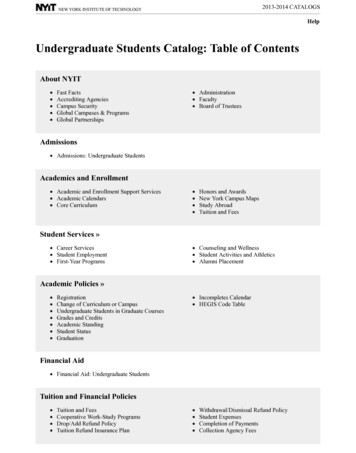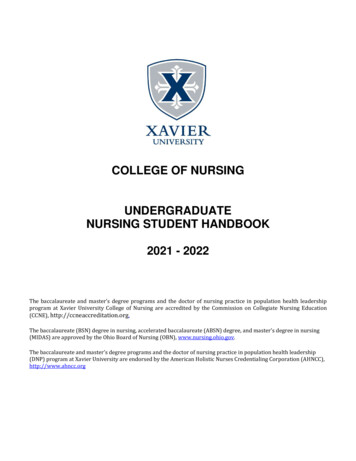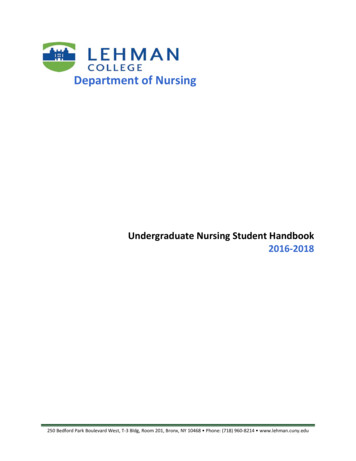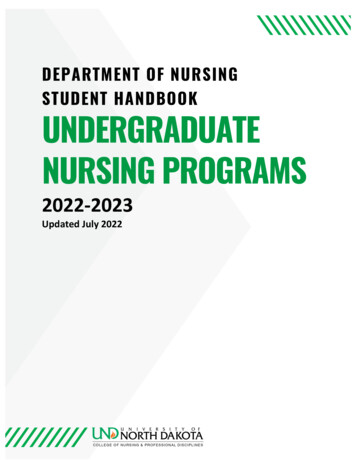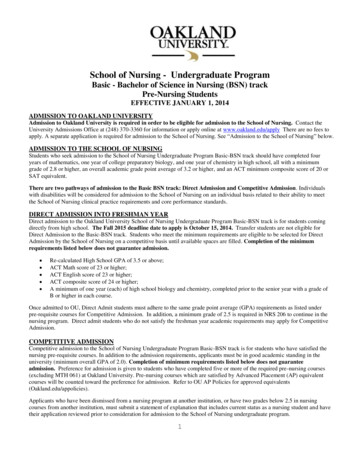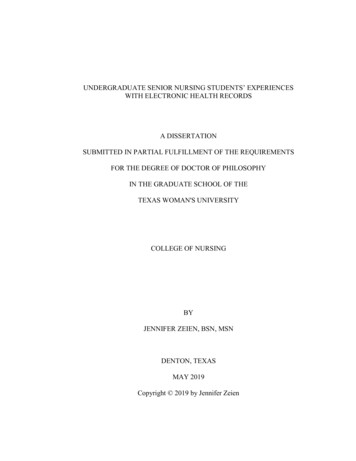
Transcription
UNDERGRADUATE SENIOR NURSING STUDENTS’ EXPERIENCESWITH ELECTRONIC HEALTH RECORDSA DISSERTATIONSUBMITTED IN PARTIAL FULFILLMENT OF THE REQUIREMENTSFOR THE DEGREE OF DOCTOR OF PHILOSOPHYIN THE GRADUATE SCHOOL OF THETEXAS WOMAN'S UNIVERSITYCOLLEGE OF NURSINGBYJENNIFER ZEIEN, BSN, MSNDENTON, TEXASMAY 2019Copyright 2019 by Jennifer Zeien
DEDICATIONTo my parents who taught me nothing in life is easy,To new nursing students, the nursing profession is challenging but so personallyrewarding,To nursing faculty the only thing constant in nursing is change.ii
ACKNOWLEDGMENTSI personally could not have survived this four year journey without the support ofmy family, friends, and co-workers.To my boyfriend Rick Pang, thank you for your support through my many stagesof education. You were always very understanding when school requirements took muchof our free time.To my parents Bill and Marilyn, you are a great example of love and perseverancethrough good times and bad.To my TWU colleagues Ellen, Ivy, and Thenga. We have survived many trialsand tribulations together. Thank you for your support and input when I needed it.To my dissertation chair, Dr. Malecha, thank you for the many supportivediscussions and guidance to get me to where I am today.To my dissertation committee members, Dr. Leslie Nelson and Dr. KarenPancheri, thank you for taking the time to support me during this journey.To my co-workers Sandy, Hema, and Kat, thanks you for listening to all mystruggles during my PhD journey.To my manager, Dr. Jennifer Collier, and Director, Susan Lee, for yourunderstanding and the flexibility to allow me to attain my goals.iii
ABSTRACTJENNIFER ZEIENUNDERGRADUATE SENIOR NURSING STUDENTS’ EXPERIENCESWITH ELECTRONIC HEALTH RECORDSMAY 2019Electronic health records (EHRs) can be used to improve patient care andoutcomes. Preparing undergraduate nursing students with health information technologies(HIT) competencies is needed to transition nursing students to the work force.Technology advancements have impacted the way nursing students are educated. Manyeducation institutions use academic EHRs and simulation as tools to develop HIT skillsin students. The challenge with hospital-based EHRs is that institution EHRs followinstitution guidelines and protocols customized for that institution. This can createchallenges and barriers for nursing faculty, students, and the University to provideadequate EHR training and to develop HIT skills. This study explored nursing students’experiences when using an EHR at different clinical sites. In this study, Colaizzi’smethodology was used to develop themes and patterns about nursing students’experiences with EHRs and utilized Edmund Husserl’s descriptive phenomenologicalapproach. Husserl’s philosophical approach allows discovery of senior nursing student’sthoughts, ideas, and experiences about using an EHR that leads to a better understandingof how nursing students use an EHR in clinical settings. Nursing students need to be ableto use electronic tools efficiently within the EHR to locate and use data effectively whencaring for patients. Understanding the nursing students’ experiences with EHR can giveiv
insight into different teaching strategies and interventions that can improve training andexperiences during clinical rotations.v
TABLE OF CONTENTSPageDEDICATION . iiACKNOWLEDGMENTS . iiiABSTRACT. ivTABLE OF CONTENTS .vChapterI. INTRODUCTION .1Focus of Inquiry .1Statement of Purpose .3Rationale for the Study .3Philosophical Underpinnings .5Research Question .7Summary .7II. REVIEW OF LITERATURE.9Overview .9Health Informatics Initiatives for Nursing Education .11Electronic Health Records and Nursing Students .13Qualitative Studies .13Quantitative Studies .15Descriptive Studies .16Usability Study.18Mixed methodology .19Gaps in Nursing Science .20Summary .21vi
III. PROCEDURE FOR COLLECTION AND TREATMENT OF DATA .24Setting .24Participants .25Protection of Human Subjects .26Data Collection .27Instrument .29Data Analysis .30Scientific Rigor/Trust Worthiness .32Pilot Study.33Theme Categories .34Theme 1 training .35Theme 2 access .36Theme 3 EHR/facility variability.37Theme 4 technology burden .38Theme 5 novice knowledge .39Theme 6 safety/practice .40Other Modifications .42Summary .42VI. ANALYSIS OF DATA .44Description of Sample.45Methods.47Findings.48Overarching Theme Continuum of Extremes “All or Nothing” .49Theme 1 EHR Burden .50Subtheme Access barriers .50Subtheme Training issues .52Subtheme Being a novice.56vii
Theme 2 EHR Variability .58Subtheme Environmental influences .59Subtheme Hospital variance .60Subtheme Prior experience with EHR .61Subtheme Navigation of EHR .62Theme 3 Technology impact .65Subtheme Electronic communication .65Subtheme Notifications and safety .67Subtheme Technology devices .68Subthemes “Workarounds .70Subtheme Brain” written notations .72Theme 4 Impact on Patient Care .74Subtheme Direct patient care .75Subtheme Time spent with patient .76Subtheme Documentation processes.77Summary .79V. SUMMARY OF THE STUDY .82Discussion of findings.83EHR Burden .84EHR Variability .87Technology Impact .90Impact on Patient Care .95Limitations of the Study.98Recommendation for Further Studies .99Implications.101Conclusion .104viii
REFERENCES .106APPENDICES .121A. Recruitment Letter .121B. Consent .122C. Demographic Questions .125D. Interview Guide/Schedule .128E. Colaizzi’s Method for Data Analysis .130F. Institutional Review Board Approval .132ix
CHAPTER IINTRODUCTIONFocus of InquiryElectronic health records (EHRs) and health information systems can lead toimproved patient outcomes and quality of care (Frimpong et al., 2013). Improving patientcare and patient outcomes are high priorities in nursing. EHRs are electronic tools thatcollect, categorize, store, retrieve, monitor, and aggregate data (U.S. Centers forMedicare & Medicaid Services, 2018). Nurses need to be prepared and trained toeffectively use and to provide safe patient care and to improve patient outcomes.Educating the current generation of nursing students with information technology skills isneeded so they can use and understand features within an EHR. The purpose of this studywas to better understand nursing students’ experience, training, and knowledge HIT skillsas they prepare to enter the nursing workforce.EHRs have become more prevalent within the healthcare field. In 2015, 84% ofhospitals adopted at least a basic EHR system and that was an 11% increase from theprevious year (Henry, Pylypchuk, Searcy, & Patel, 2016). HIT, such as EHRs, hasimpacted the way nursing students are educated and trained. It was estimated that thereare more than 300 EHR systems in the healthcare industry (Jolly, 2011). Nursing studentscan therefore be exposed to a variety of different EHRs during their clinical rotations. Italso can be challenging for nursing faculty to remain current on all features within eachinstitution based EHR. The Technology Informatics Guiding Education Reform (TIGER)1
initiative stresses the importance of informatics competencies in nursing curriculum(Healthcare Information and Management System Society, 2008). Some of thechallenges that can impact nursing students’ clinical experience with the EHR caninclude: variations in EHR platforms, access to EHR platforms, training with EHRplatforms, complexity of EHR platforms, and novice knowledge of EHR platforms.As EHRs become more complex, nursing students need to be able to access andanalyze the data contained within the EHR to be able to make clinical decisions whencaring for patients during their clinical rotations. EHRs are developed and built withhospital-specific requirements that focus on patient care and providers’ workflows. Also,each institution controls the access, training, and procedures established within theirinstitution base EHR. Other challenges that can impact nursing students experience withthe EHR include variations with institution-specific rules and regulations built within theEHR. Institution-based EHRs software programs are developed and maintained by thatinstitution. Clinical sites and EHR utilization at different locations can vary and can leadto a discrepancy in student and faculty training (George, Drahnak, Schroeder, &Katrancha, 2016).Statement of PurposeThere are limited research studies on nursing students’ experiences using an EHRin clinical settings. The purpose of this phenomenological study was to gain a betterunderstanding of nursing students’ experiences with EHRs in acute care settings duringtheir clinical rotations. Structured interviews were used to identify the connections andinteractions between EHR technology and the nursing student. This study will lead to a2
better understanding of nursing students’ EHR experiences and give insight intostrategies that can be developed to improve clinical rotations. Identifying antecedents andconsequences in data analysis may lead to a better understanding of diverse perspectivesto fully understand nursing students’ clinical experiences. In general, urban areas canhave many different acute care facilities with many different types of EHR softwareprograms. It can be challenging for nursing students to be proficient in using manydifferent EHRs during their clinical rotations. Depending on the clinical rotation andsemester, the nursing student can be exposed and trained on many different EHRsystems. Understanding the lived experience of nursing students’ use of an EHR inclinical rotations is important because barriers and gaps can be identified that can be usedto formulate strategies to improve training and access to support safe nursing care.Rationale for the StudyThis study is needed to be able to understand from a nursing student perspective,how they use an EHR, and any facilitators or barriers to EHR efficiency. EHRs can helplower the chances of medical errors, prevent duplicate tests, and may improve the overallquality of care (U.S. Centers for Medicare & Medicaid Services, 2018). Nursing studentsneed to be able to find patient data and understand how to use electronic tools for optimalpatient outcomes. Each EHR system is designed to improve patient safety, improveefficiency, reduce costs, prevent errors, and support care delivery of care through healthand disease progression (Steinwachs & Hughes, 2008). EHR functionality, clinicaldecision support systems, computerized order entry systems, and health informationexchange are all institution specific tools contained with an EHR (Menachemi & Collum,3
2011). EHR functionality, as well as policies and procedures that students must follow,can vary between institutions. This study explored how different EHR platformsimpacted how nursing students deliver care.Some healthcare institutions have challenges to meet their own institutioninformation technology needs and may have limited resources and other barriers tonursing student training (Fetter, 2009). Depending on the training and the access grantedto students, this could impact their clinical experiences. Nursing educators need to beable to use and understand EHR functionality in each institution to be an effective clinicalinstructor. It is the nursing preceptors and nursing clinical instructors who assist nursingstudents to understand how to use and navigate the EHR to deliver safe quality care. Bothorganizational and behavioral attitudes towards the use of an EHR can impact individualusers (Menachemi & Collum, 2011). The potential benefits of EHRs include improvedquality outcomes, reduced medical errors, improved ability to conduct research,improved population health, and reduced costs (Menachemi & Collum, 2011). Healthcareinstitutions and educational programs need to establish educationally sound, costeffective, secure policies, and secure procedures for managing students' use ofinformation technology systems (Fetter, 2009).Philosophical UnderpinningsEdmond Husserl used consciousness and personal experiences to studyphenomenology, the idea that consciousness has intentionality. That means intentionactions are directed at objects or ideals (Kleinman, 2013). Phenomenology reflects uponthe individual experience to gain some understanding of its underlying order, structure,4
and logic. Husserl’s philosophical approach aligned well with this research aimed atdiscovering and understanding senior nursing students’ experiences with the EHR.Phenomenology uses awareness of nature and reality of consciousness to better exploreprocesses and concepts. Phenomenology is the interpretation of an experience by relatingit to relevant features of context (Smith, 2013). Uncovering senior nursing students’thoughts, ideas, and experiences with an EHR may lead to a better understanding of thebarriers and facilitators when using an EHR in clinical rotations. Husserl’s philosophytries to explain the experience of a phenomenon as perceived by human consciousness,which should be an object of scientific study (Lopez & Willis, 2004). The phenomena ofnursing students’ experiences using EHR is important because it can give insight into anindividual’s experience. Some factors that can influence the experience of the EHRinclude organizational structure, technological advances, training, and behavioralinfluences (Menachemi & Collum, 2011).The “life world” described by Husserl is the world lived through everydayexperiences within the physical surroundings of their environment (Husserl, 1936/1970).The phenomenological approach attempts to give a thoughtful, methodical understandingof the “life-world” and how the “world is lived.” The phenomenological approach fitswell with the research methodology because the EHR is not an entity alone but embeddedin the healthcare environment of the institution. Phenomenology research attempts to gaina deeper understanding of the meaning of people's everyday experiences (Polit & Beck,2012). During clinical rotations, nursing students are immersed in the health careenvironment and using the EHR. The lived experience further investigates an individual5
awareness of his or her self-conception. Self-concept in this study was explicitly relatedto the individual’s beliefs and knowledge about their ability to use technology. There areinternal, external, and regulatory factors that can impact a nursing student’s experiencewhen using an EHR. In addition, understanding the different experiences from the studentperspective can better clarify their beliefs, processes, thoughts, ideas, awareness,knowledge, and interaction in different situations when using an EHR. Identification ofthemes and associations shared by nursing students when using an EHR can give insighton how to improve hospital-based clinical experience and training. Given the lack ofresearch on this phenomenon, it was proposed that this study might foster additionalresearch to further understand the lived experience of students’ use of EHRs in differentsettings with different student populations.Husserlian phenomenology suggests using bracketing to allow the researcher toacknowledge personal biases, assumptions, presuppositions, and put them aside (Gearing,2004). Journaling was done by the researcher to assist with discovering anypresuppositions or biases that may arise given the researcher’s experience with the designof one of the EHRs identified in the research. Journaling was vital because it identifiedsome personal bias and allowed for awareness to not impact or lead participants.Journaling allowed for an openness of the researcher to identify both positive andnegative aspects of the EHR. It also allowed for the knowledge to further probe to explainEHR experiences better.6
Research QuestionAs technology advances in health care, nursing students need to access, use, andnavigate through an EHR. To understand how a student experiences using an EHR duringtheir clinical rotation this study was developed. This study answered the followingresearch question: What are the lived experiences of senior nursing students’ using an EHRwhile providing care in an acute care setting?SummaryThis study focused on the lived experience of a nursing student using an EHR in aclinical experience using the phenomenological perspective of Edmond Husserl. Nursingstudents can have unique and different clinical experiences when using an EHR. Nursingstudents need to use, access, and understand data contained with the EHR to learn anddeliver nursing care. EHRs provide clinicians with up-to-date information about patients’medical conditions, treatments, tests, and prescriptions (U.S. Centers for Medicare &Medicaid Services, 2018). The nursing students in this study expressed a variety of EHRexperiences with processes, facility variances, and lack of exposure. Participants reporteda variety of challenges that caused barriers to delivering care. Some challenges reportedincluded a variety of institutional differences with access, training, policies, and chartingrequirements. This study discovered from a nursing students’ perspective barriers andfacilitators contained within EHRs and focused on understanding the essence of their“experience” and reality during their clinical rotations. This study also identifiedinstitutional and EHRs variabilities such as lack of standardization of EHRs and7
workplace environment that impacted students’ clinical experiences. Healthcare deliveryrequires timely information for effective decision making using information technologyto prepare nurses for practice (McNeil et al., 2003). Supportive and interactive clinicalenvironments can allow nursing students to learn and effectively use EHR technology todeliver care.8
CHAPTER IIREVIEW OF LITERATUREOverviewWithin the literature, electronic medical record (EMR) and EHR are terms thatcan be misused, as there is a difference between the two terms. The term EMR was firstintroduced when paper was replaced with computer data. An EMR is a digital version ofa patient’s chart used by a group or groups of physicians’ practices (Garrett & Seidman,2011). An EMR contains the patient’s medical history, diagnoses, and treatments by aphysician, nurse practitioner, specialist, dentist, surgeon, or clinic (Garrett & Seidman,2011). An EHR is also a digital version of a patient chart but is a more inclusivecollection of the patient’s medical data that can be shared with other providers acrossfacilities (Garrett & Seidman, 2011), if they have appropriate access. The data containedwithin the patient’s EHR allows for immediate access to real-time data that canstreamline care coordination between all providers. Electronic features contained withinEHRs can assist with reminders and documentation requirements. Nurses need to accessand use an EHR system quickly and efficiently to decrease facility expenditures, improvepatient safety, reduce healthcare costs, and support meaningful-use reimbursement (King,Patel, Jamoom, & Furukawa, 2014).Healthcare institution-based EHRs are developed within institutions’ guidelinesand workflows to meet the needs of the institution and maintain patient safety. Healthcareinstitution-based EHRs are not built specially for the needs of students, but students can9
be end-users that need to access and use data contained within the EHR when caring forpatients during their clinical rotations. In the current literature, there is limited qualitativeand qualitative research that focuses on nursing students and experiences with an EHRduring their clinical rotations. This limited literature necessitates the need for furtherresearch. The Health Information Technology for Economic and Clinical Health(HITECH) Act of 2009 was signed into law to encourage widespread use of EHRs(Menachemi & Collum, 2011). Technology is advancing in all aspects of healthcare thusunderstanding how nursing student experience the EHR in clinical settings can assistnursing educators to better prepare the student to transition to the registered nurse role.A considerable amount of the literature focuses on registered nurses experiences,competencies, or usability with EHRs and there is limited research on nursing students’experiences with EHRs. Every EHR can be designed with prompts, pop-ups, and reportsto meet the needs of regulatory bodies and institution requirements. Nursing programsneed to prepare nursing students with HIT skills to be able to use the electronic toolscontained within the EHR to deliver care. It was out of the scope of this study to evaluateHIT skills of the participants; however, some technology described in the study included:EHRs, simulation, online modules, and mobile devices. EHRs used in conjunction withsimulation-based learning can assist with documentation and evaluation of clinical datafor patient care decisions and students’ readiness to transition into practice (Badowski,Horsley, Rossler, Mariani, & Gonzalez, 2018). Using simulations incorporated with anEHR can also increase exposure to information technology in a safe and supportiveenvironment. A study by George et al. evaluated integration and exposure to EHR in10
simulation and the improvement with student speed in documentation while maintainingaccuracy (George, et al., 2016). Thus, while exposure to EHR processes withinsimulation may prepare students, some academic EHRs may not be as robust and canlack the integration processes that institution-based EHRs contain. A Greek studydiscovered positive perceptions of nursing students with an EHR and training ofassessments could assist with health informatics concepts within EHRs (Gallos,Daskalakis, Katharaki, Liaskos, & Mantas, 2011).Health Informatics Initiatives for Nursing EducationThe Technology Informatics Guiding Education Reform (TIGER) initiativefocused on basic computer competencies, information literacy, and informationmanagement (Healthcare Information and Management System Society, 2008).Innovators need to use technology to develop and discover new processes and improvethe care they give. An integrative team approach is necessary to maintain a constantevaluation of the evidence and technology. The goal of TIGER is to: Develop education curriculum through the integration of IT, informationliteracy, informatics, and the infusion of technologies. Develop and implement learning innovations; fostering facultydevelopment and ensuring universities and providers have the necessaryhealth IT education infrastructure. Identify, model, and implement collaborative partnerships among publicand private academic enterprises to launch a graduate student internInformatics Scholar Program.11
Increase faculty and student acceptance and understanding of health ITtechnology through education and training, incentives and necessarysupports (Healthcare Information and Management System Society,2008).These initiatives need to be integrated into nursing programs to prepare nursingstudents with HIT skills and allow them to use those skills developed in clinical rotationsto prepare them to transition to the workforce. Nursing schools frequently rely on theclinical practicum
To my TWU colleagues Ellen, Ivy, and Thenga. We have survived many trials and tribulations together. Thank you for your support and input when I needed it. To my dissertation chair, Dr. Malecha, thank you for the many supportive discussions and guidance to get me to where I am today.

